I first came across Mid-Century Modern furniture while helping a friend furnish a tiny apartment, and it immediately caught my eye.
The clean lines, tapered legs, and warm wood felt fresh yet familiar, and I wanted to know why it still works so well decades later.
If you’ve been curious about this style too, you’re not alone. Its mix of function and understated beauty continues to show up in homes of every size.
In this guide, I’ll walk you through where Mid-Century Modern furniture came from, how to recognize authentic pieces, and easy ways to use them in your own space so you can enjoy its classic look without guesswork.
What is MCM Furniture?
Mid-Century Modern (MCM) furniture refers to a design style that emerged between the 1940s and 1960s during a period of rapid innovation in home living. It’s recognized for clean lines, geometric shapes, and an emphasis on practicality without excess decoration.
The term “Mid-Century Modern” itself was coined decades later to describe the look of that era’s furniture and interiors. Beyond furniture, MCM represents a wider architectural and interior design movement that reshaped homes and public spaces.
Mid-Century Modern also describes a wider architectural and interior design movement. Homes built during this period featured low, horizontal lines, large windows, and open floor plans designed to complement the furniture.
Understanding this connection helps you see how MCM furniture fits naturally into today’s spaces as well.
Origins of Mid-Century Modern Furniture
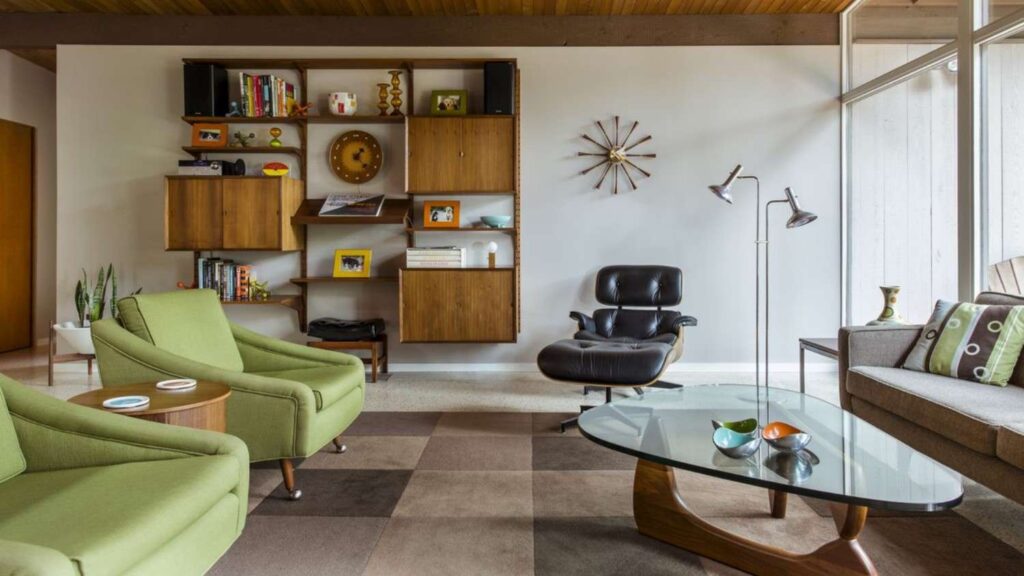
Before we get into where Mid-Century Modern furniture came from, it’s good to know why it still matters today. This style isn’t just about looks; it changed the way people thought about home design:
Post–World War II Optimism
Mid-Century Modern furniture grew out of a hopeful postwar culture focused on rebuilding homes and lifestyles. Designers sought to simplify daily living while reflecting progress and optimism.
Clean lines and open layouts emerged as symbols of a new start. Affordable materials and lighter forms replaced the heavy, ornate furniture of earlier decades.
This shift allowed more families to create comfortable, stylish interiors that matched a forward-looking society and laid the groundwork for decades of modern design influence.
Rise of Mass Production and Affordability
Advances in manufacturing after World War II allowed designers to produce high-quality furniture at scale.
Factories used new techniques and materials such as plastics, laminates, and molded plywood to create lighter pieces at lower costs. This opened modern design to everyday households rather than only the wealthy.
Catalog sales, department stores, and exhibitions spread the style quickly. Mass production turned Mid-Century Modern from an elite trend into a mainstream movement, changing how people furnished their homes.
Designers and Influencers
Key figures such as Charles and Ray Eames, George Nelson, and Arne Jacobsen defined Mid-Century Modern furniture. They introduced molded plywood, fiberglass chairs, and sleek storage systems through brands like Herman Miller.
Danish Modern emphasized craftsmanship and natural woods, bringing warmth to clean silhouettes. These innovators blended art and function, creating accessible designs that still feel current.
Their work shaped homes, offices, and public spaces, proving modern furniture could be comfortable, attractive, and affordable at the same time.
Cultural Impact of MCM Style
Mid-Century Modern furniture changed more than interiors; it reshaped how people lived. Open floor plans, indoor-outdoor flow, and multi-use pieces reflected a culture moving toward casual living, family gatherings, and efficiency.
Workplaces also adopted sleek, modular layouts inspired by the same principles. This shift mirrored broader social changes of the mid-20th century, where design promoted optimism, innovation, and democratic access to good style.
The influence continues today, making MCM a symbol of progress and simplicity.
Timeline of MCM Evolution
| Decade | Key Innovations & Trends | Notable Features | Design Highlights |
|---|---|---|---|
| 1940s | Early postwar innovations | Focus on function and simplicity; use of new industrial materials after WWII | Introduction of molded plywood (Charles & Ray Eames); affordable modern furniture emerges |
| 1950s | Rise of molded plywood and fiberglass | Sleek, organic forms; emphasis on comfort and mass production | Eames Lounge Chair, Saarinen Tulip Chair, Nelson benches |
| 1960s | Bold color and modular furniture | Playful palettes; flexible layouts; influence of pop culture | Space-age shapes, vibrant plastics, modular storage systems |
| 1970s | Shift toward environmental awareness and new plastics | Earth tones, natural materials, and sustainability influence design | Blending of modernism with organic design; rise of eco-conscious manufacturing |
Key Characteristics of MCM Furniture
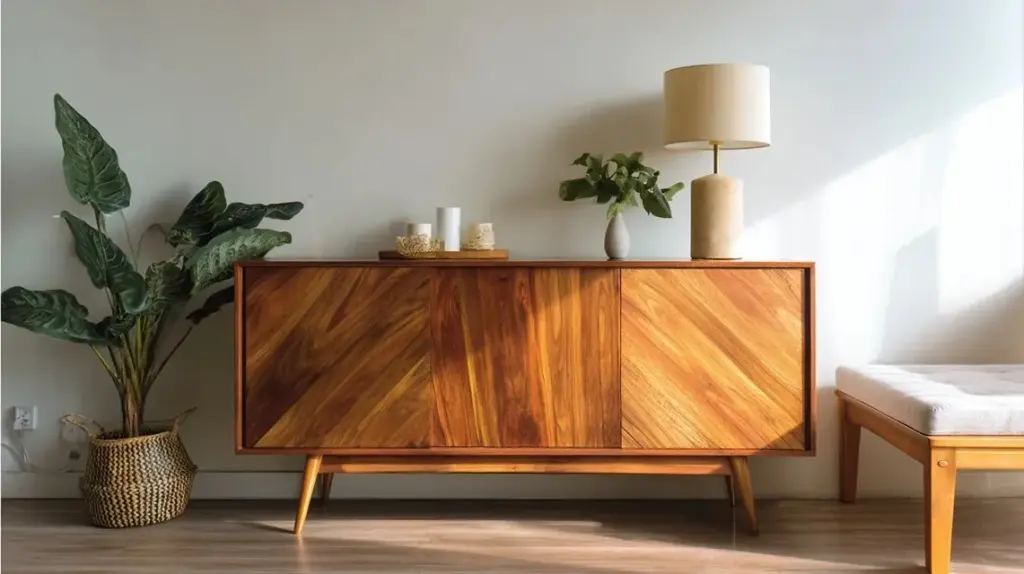
Mid-century modern furniture highlights simplicity, practicality, and distinctive shapes, utilizing natural and innovative materials that remain appealing today. Here are the key features that define this style:
1. Clean Lines and Geometric Shapes
MCM furniture uses sharp, simple lines and basic geometric shapes to create uncluttered pieces. Tables, chairs, and storage units show straight edges or gentle curves with no heavy decoration.
The focus on form makes furniture appear lighter, more open, and easy to fit into many settings, from small apartments to larger homes, without feeling dated or crowded.
2. Organic Forms and Bold Colors
Alongside clean lines, MCM incorporates soft, natural curves inspired by plants and landscapes. Armchairs may feature flowing silhouettes, while tables have rounded edges.
Color palettes combine earthy tones with bright pops, such as orange, turquoise, or mustard, to add energy. These contrasts bring warmth and personality to spaces, making MCM furniture stand out while still blending seamlessly with various décor styles, keeping rooms lively yet balanced.
3. Natural and Innovative Materials
MCM furniture often features woods like teak and walnut for their warmth and strength. Designers also adopted new materials, such as fiberglass, molded plywood, and plastics, to create lighter, more affordable pieces with innovative shapes.
Combining these elements gave the look its distinct identity, merging tradition with progress. This material mix makes vintage MCM items durable, and it continues to influence modern furniture production and sustainable choices today.
4. Functionality and Minimalist Design
Function comes first in MCM furniture. Pieces are designed to be practical, comfortable, and space-saving, without unnecessary decoration. The minimalist approach means fewer heavy details and more open surfaces, so rooms feel larger and easier to use.
Storage units double as display pieces, chairs are lightweight yet supportive, and tables serve multiple purposes. The result is a clean, uncluttered environment that feels organized and welcoming.
Why MCM Furniture Remains Popular?
Mid-century modern furniture remains relevant because it strikes a balance between beauty, practicality, and classic design. Here’s why it still works today:
- Simple, Recognizable Design: Its clean lines and geometric forms create a sense of balance that feels both classic and modern in any room.
- Functional for Everyday Living: MCM pieces are made for real use, comfortable, durable, and practical without sacrificing good design or proportion.
- Works in Any Space: Light silhouettes and minimal detailing make rooms appear open and uncluttered, even in small apartments or tight layouts.
- Natural Warmth and Texture: Teak, walnut, and other natural woods add warmth and authenticity, grounding interiors with organic beauty and depth.
- Easy to Maintain Over Time: High-quality materials and craftsmanship ensure these pieces last for decades with minimal upkeep or special treatment.
- Accessible Through Modern Reproductions: Faithful replicas from today’s brands make it easy to achieve the MCM look across different budgets and design needs.
- Classic Adaptability: Its balance of simplicity and function allows MCM furniture to blend with new styles while staying effortlessly current.
Recognizing True Mid-Century Modern Pieces
When you’re trying to identify authentic Mid-Century Modern furniture, keep these key details in mind. Each point below highlights a reliable sign to help you tell originals from copies:
Maker’s Marks, Labels, and Key Designers
Look for maker’s marks, serial numbers, or branded labels on the underside, back, or inside drawers. Many original pieces include stamps or paper tags naming designers like Eames or Nelson.
Cross-check these markings with reliable databases or reference books. Knowing the designer or manufacturer adds confidence that the furniture is genuinely from the mid-20th century rather than a later reproduction.
Construction Details and Materials
Understand how a piece is built and what it’s made from to spot genuine Mid-Century Modern furniture.
- Look for solid wood frames rather than particleboard.
- Check for dovetail joints and smooth, even edges.
- Teak, walnut, or molded plywood shows quality and age.
- Consistent grain and rich color often signal authenticity.
- Avoid staples, rough finishes, or flimsy hardware that suggest reproductions.
Pricing Tiers and Reproduction Red Flags
True mid-century pieces tend to cost more due to scarcity, designer reputation, and material quality. Be cautious of deals that seem too low or of mass-market versions claiming authenticity without proof.
Research typical price ranges for specific designers or item types before purchasing. Understanding the market helps avoid paying premium prices for reproductions and ensures you’re investing in genuine furniture.
Styling MCM Furniture
Styling MCM furniture is all about balance by mixing vintage character with modern comfort. Here are a few simple ways to style your pieces so they stand out while keeping your space warm and inviting:
1. Modern Farmhouse Combinations
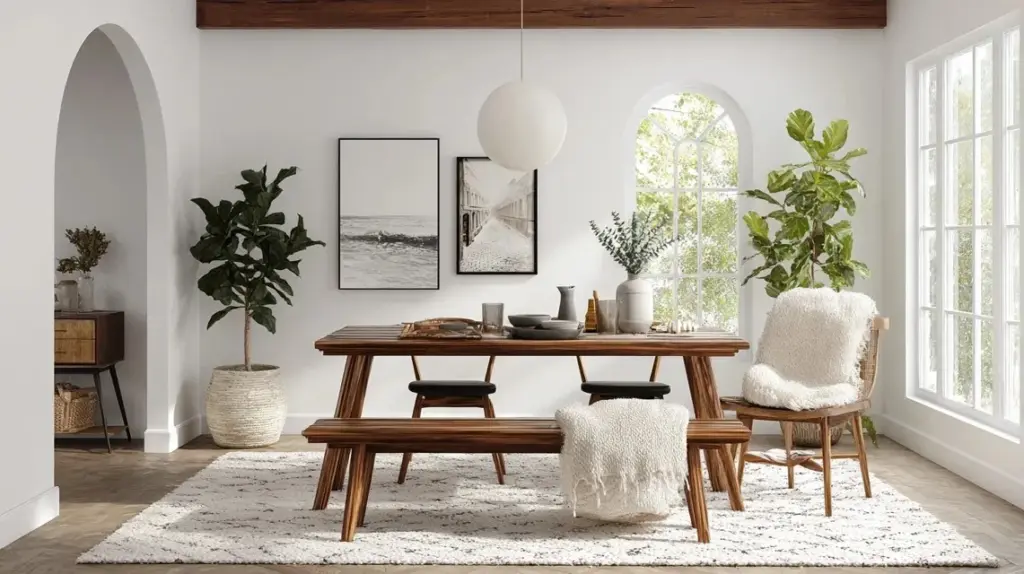
Combine MCM’s sleek shapes with farmhouse warmth for a cozy yet polished look. Pair walnut or teak furniture with white walls, woven rugs, and soft linens. Keep décor minimal, try ceramic vases, matte black fixtures, or simple metal lamps.
Tip: Hang a mid-century pendant above a rustic dining table to blend farmhouse charm with MCM sophistication effortlessly.
2. Scandinavian Influences
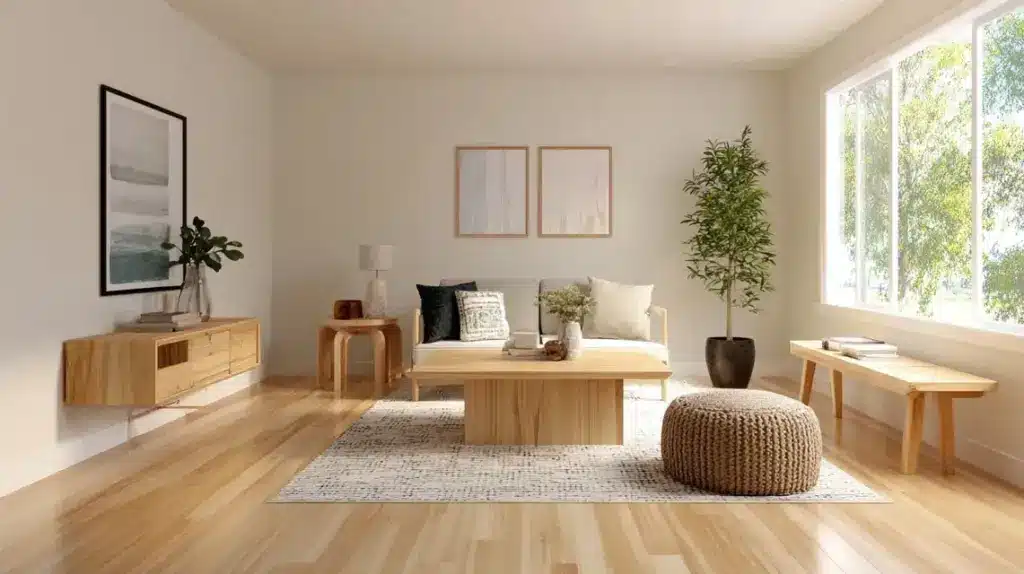
Scandinavian and MCM designs both favor simplicity, function, and light. Use pale woods, muted tones, and minimal clutter for a bright, calming environment. Add warmth with textured fabrics such as wool throws or leather accents.
Tip: Limit your color palette to whites, light grays, and soft blues, letting natural materials and clean lines create the visual depth.
3. Minimalist Interiors
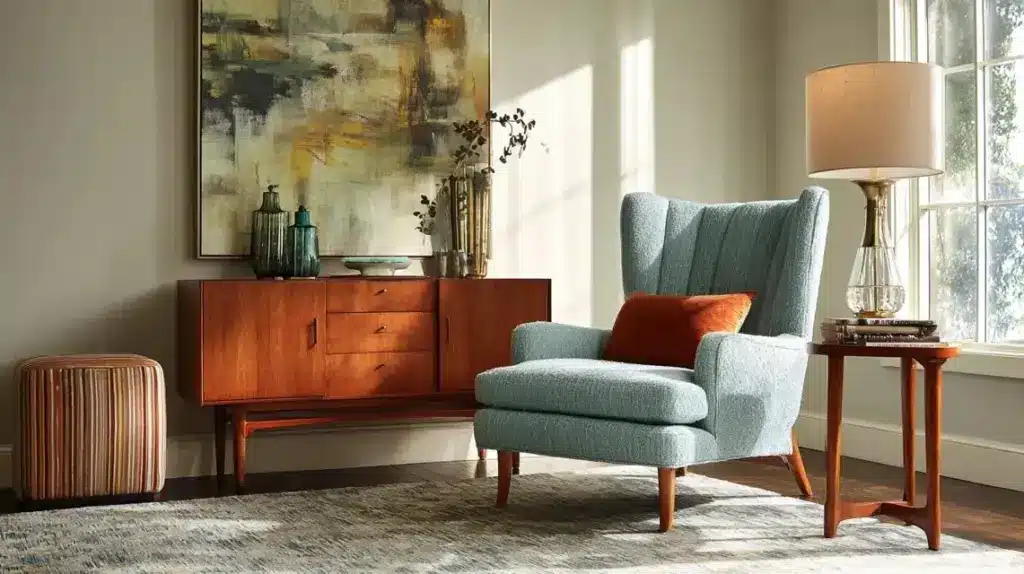
Focus on one or two bold MCM pieces to define your room. A walnut credenza, molded chair, or glass-top coffee table makes an impact without overpowering the space. Keep walls neutral and surfaces clear to highlight craftsmanship.
Tip: Fewer items, thoughtfully arranged, create a sense of harmony; one sculptural lamp or patterned rug can complete the look.
How to Bring Mid-Century Modern Style into Your Home?
Here’s how you can bring Mid-Century Modern style into every corner of your home. From the living room to the bedroom, each space offers a chance to show off clean lines, warm wood tones, and timeless design in your own way:
Living Room
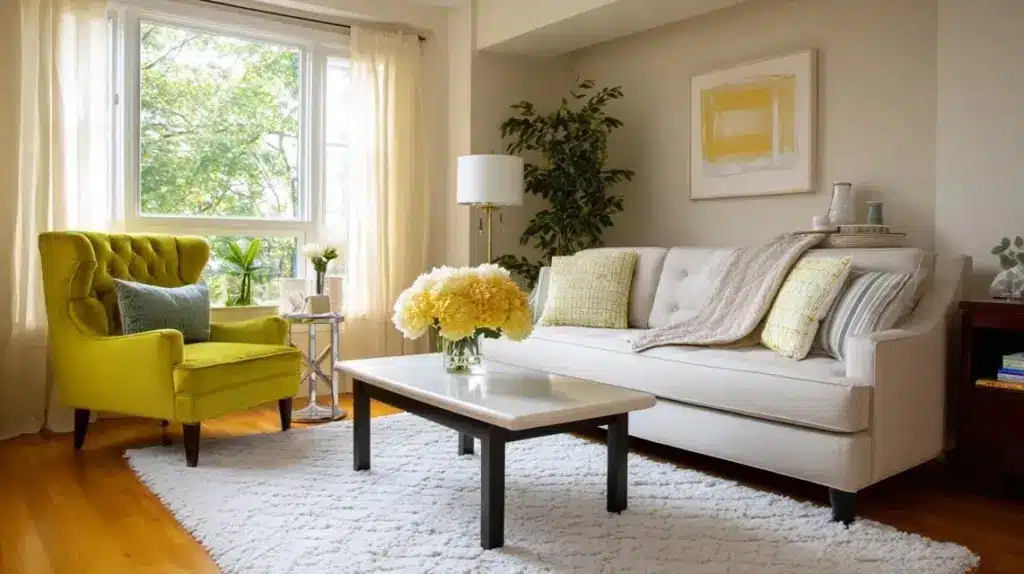
Use low-profile sofas with tapered legs to keep the space open. Pair them with slim coffee tables or nesting tables for flexibility. Add one accent color, like mustard or navy, through cushions or wall art. Include warm wood tones for balance.
Tip: Keep walkways clear and let natural light emphasize the furniture’s clean silhouettes.
Bedroom
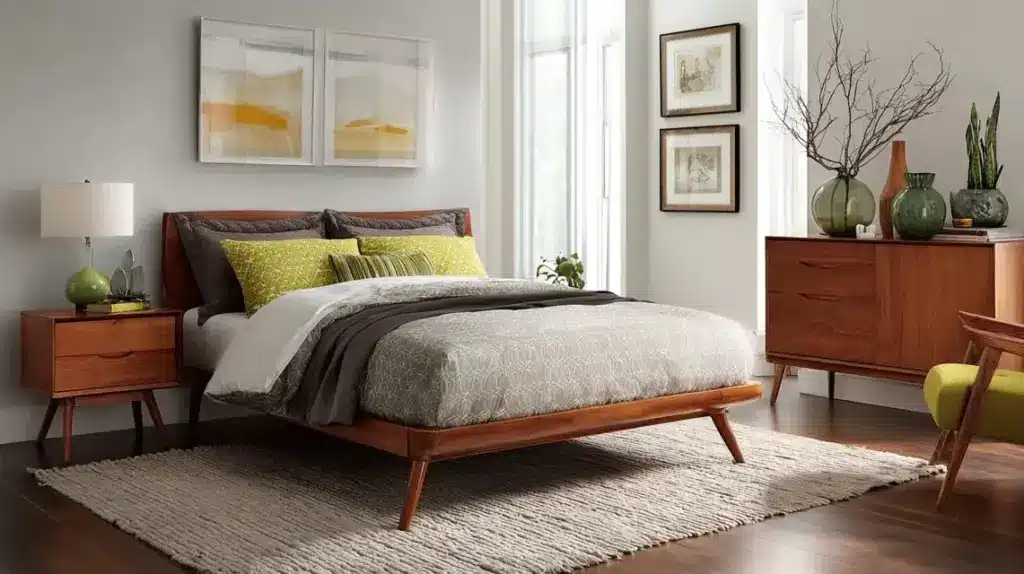
Choose a wooden bed frame with matching nightstands for a cohesive base. Stick to soft, neutral bedding and introduce warmth with a wool throw or textured rug. Add a single pop of color through a retro lamp or framed print for interest.
Tip: Keep the layout minimal to promote calm and highlight the furniture’s craftsmanship.
Dining Area
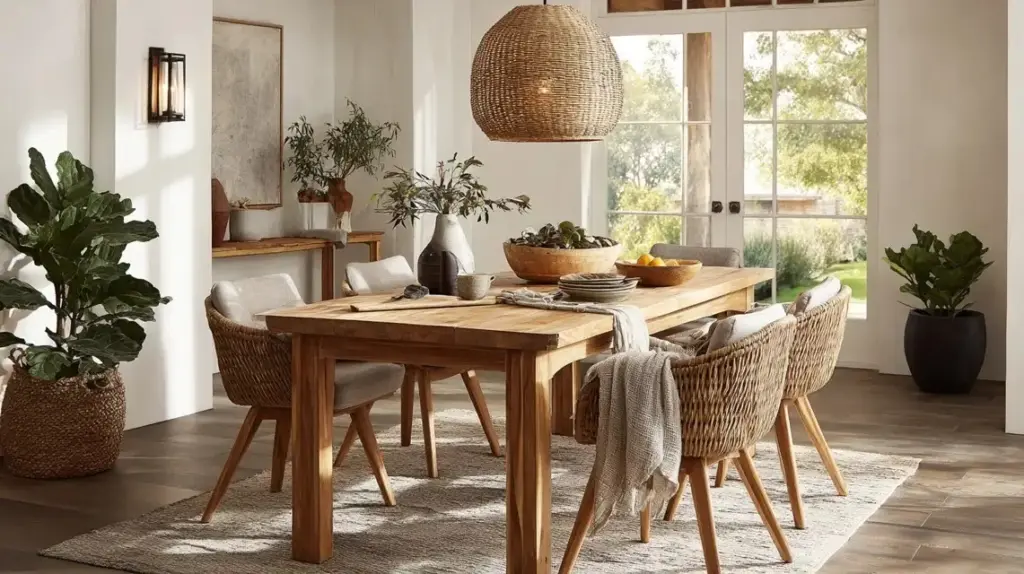
Place a round or rectangular teak table at the center and pair it with molded plastic or fiberglass chairs. A globe pendant or cone-shaped light overhead adds a period touch. Keep table décor minimal, just a vase or woven runner.
Tip: Maintain symmetry and space around each piece to preserve the open, uncluttered mid-century feel.
Caring for MCM Furniture
Keeping your Mid-Century Modern furniture in good shape is simple with a bit of regular care. Here are some easy ways to protect the wood, keep the finishes looking smooth, and make sure your pieces last for years:
Wood and Veneer Protection
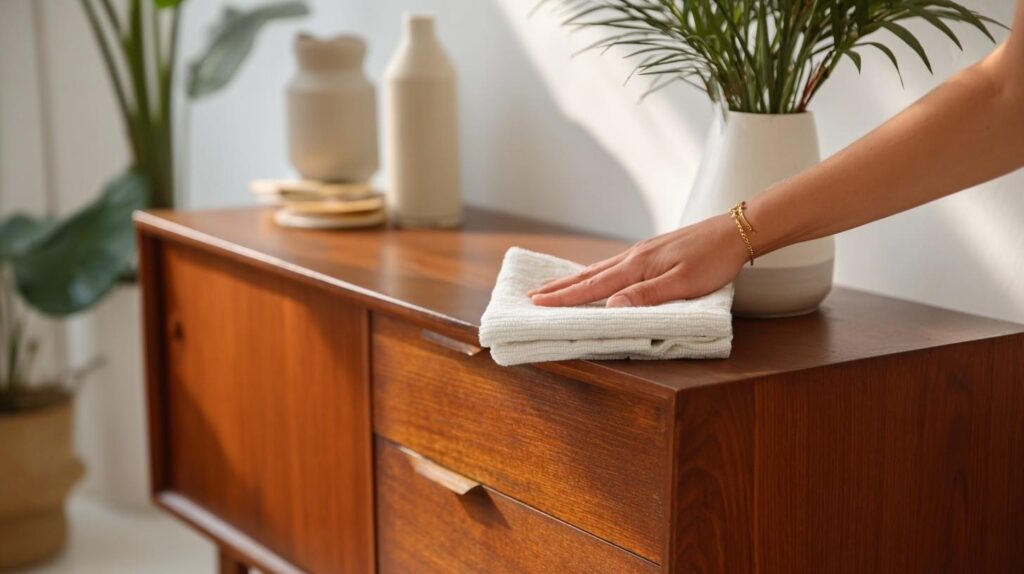
Mid-Century Modern pieces made from teak or walnut need gentle care to stay vibrant. Dust regularly with a soft cloth and clean spills quickly to prevent staining. Use coasters and mats to protect from heat or moisture.
Apply teak oil or wood polish twice a year to restore luster. Avoid harsh cleaners and direct sunlight, as both can dull or dry the finish over time, reducing the furniture’s natural warmth.
Fabric and Upholstery Care
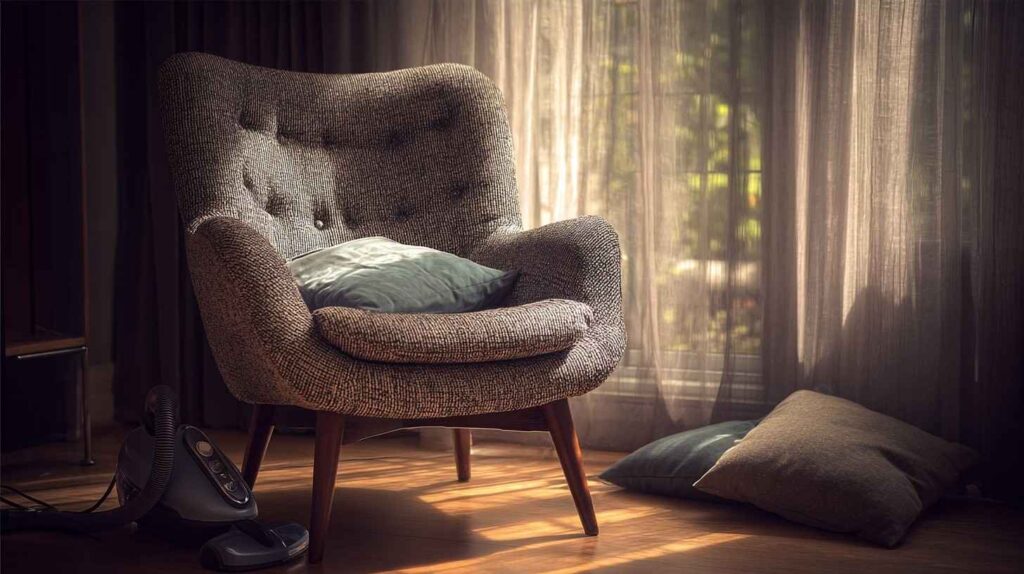
Keep upholstered furniture fresh with regular maintenance. Vacuum cushions weekly and rotate them to prevent uneven wear. Blot spills gently with a clean cloth; never rub, as it spreads stains.
For deeper cleaning, use mild upholstery shampoo or hire professionals. Avoid strong sunlight to prevent fading, especially on vintage fabrics. Slipcovers can help preserve delicate upholstery in high-traffic areas while allowing easy updates without altering the original piece’s look or structure.
Plastic and Fiberglass Maintenance
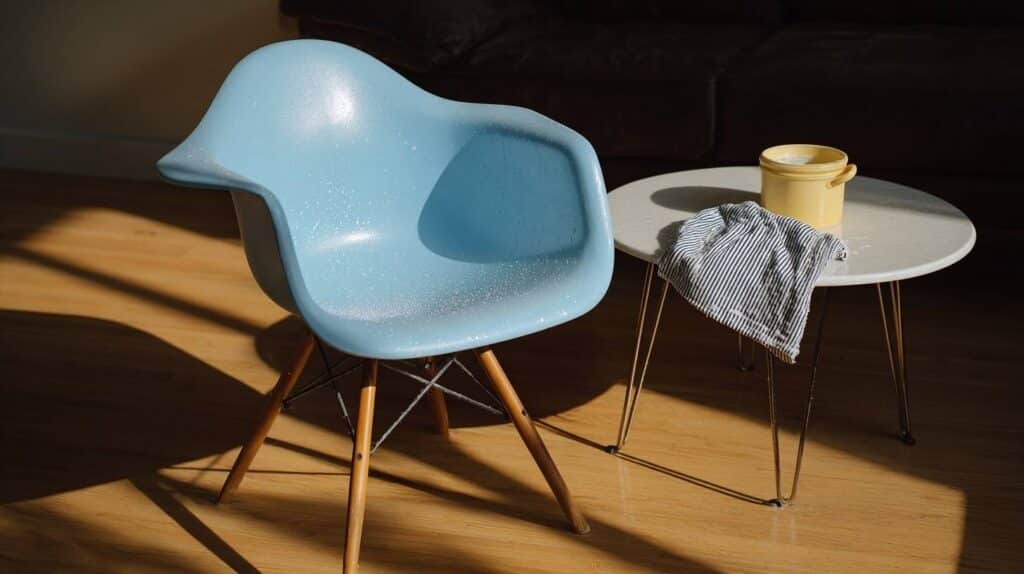
Many MCM classics feature molded plastic or fiberglass, prized for their sculptural forms. Clean them using mild soap and a damp cloth, avoiding abrasive cleaners that scratch the surface. For dull finishes, apply a light coat of automotive wax to restore shine.
Check metal fittings and screws regularly to maintain stability. Keep these materials away from direct heat or extreme cold, which can cause cracking or discoloration, ensuring their sleek appearance lasts for decades.
Buying MCM Furniture Today
Mid-Century Modern furniture is easy to find through vintage shops, auctions, and online retailers offering both originals and reproductions.
Cities like Palm Springs, Los Angeles, and Copenhagen are known hotspots for authentic finds, often featuring estate sales and design fairs filled with verified pieces.
Prices vary widely; an authentic Eames molded chair might cost $800–$2,000, while a Danish teak sideboard could range from $1,500–$5,000.
Reproduction pieces inspired by these classics are more affordable, typically between $300 and $800, making the MCM look accessible for any budget.
Buying vintage MCM furniture also supports sustainability. Each piece is built to last, crafted from durable materials like teak and walnut that age beautifully.
Choosing pre-owned items helps reduce waste and keeps furniture out of landfills while maintaining timeless style. Whether you buy one statement chair or a full set, MCM furniture blends design, practicality, and eco-friendly appeal.
Summing Up
I’ve always admired how Mid-Century Modern furniture brings together beauty, comfort, and purpose so naturally. The clean lines, natural materials, and balanced design make every space feel calm yet full of life.
Even a single piece, such as a chair, lamp, or sideboard, can change the mood of a room and make it feel more grounded and welcoming. It’s a style that never feels forced, just quiet class.
Now it’s your turn to bring that feeling into your home. Try adding one piece and see how it changes your space. You’ll notice how easily it mixes in and adds warmth without effort.
If you want more simple ways to design a classic, cozy home, check out my other guides for fresh ideas and tips!














